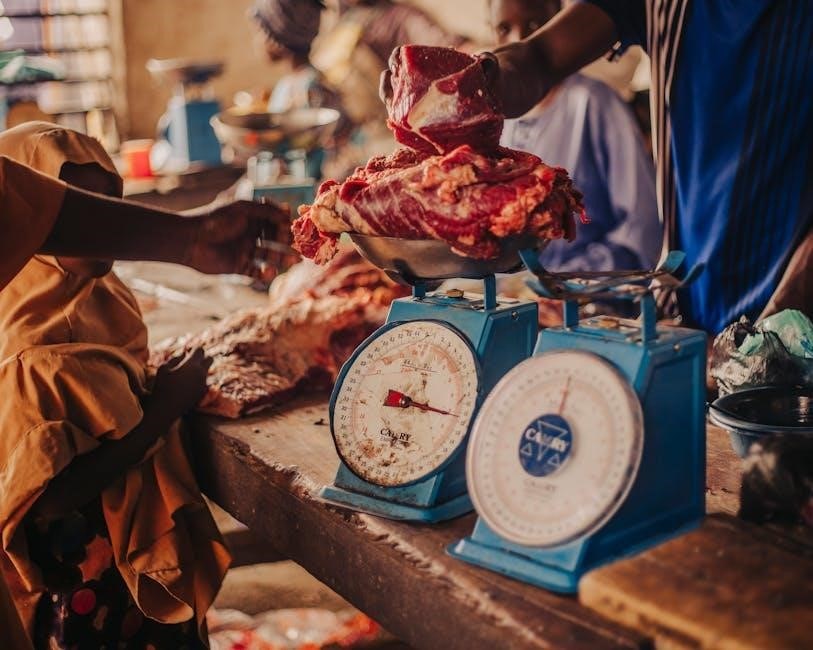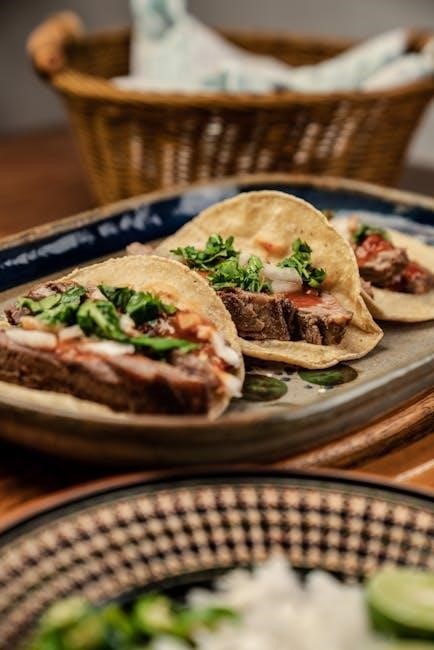Understanding Different Types of Meat
Meat varies by animal, cuts, and quality, with beef, pork, and poultry being the most common. Each type offers unique flavors, textures, and cooking methods.
1.1 Beef
Beef, a staple in many cuisines, is renowned for its rich flavor and versatility. Popular breeds like Angus and Wagyu offer superior quality. Originating from regions like the Midwest, beef is prized for its marbling, which enhances tenderness and flavor. Grass-fed and grain-fed options cater to different tastes and preferences, ensuring variety for consumers.
1.2 Pork
Pork, known for its juicy texture and hearty flavor, offers a wide range of cuts from tender loins to flavorful shoulders. Popular breeds include Hampshire and Duroc, each providing unique qualities. Pork is a versatile meat, suitable for roasting, grilling, or curing, making it a favorite in many global dishes and cuisines.
1.3 Poultry
Poultry includes chicken, turkey, and duck, each offering distinct profiles. Chicken is a versatile favorite, while turkey is often reserved for special occasions. Ducks provide rich, savory flavors. Freshness and ethical sourcing are key for quality, ensuring tender and flavorful meat for various cooking methods and global recipes.

Factors Influencing Meat Quality
Meat quality is shaped by genetics, diet, aging, and handling practices, ensuring tenderness, flavor, and safety for consumers.
2.1 Breed and Genetics
Breed and genetics significantly influence meat quality, with certain breeds known for marbling, tenderness, and flavor. For example, Wagyu cattle are renowned for their rich, buttery meat due to genetic traits. Understanding these factors helps buyers choose meats that meet their taste and texture preferences effectively, enhancing culinary experiences.
2.2 Feed and Nutrition
Feed and nutrition play a crucial role in meat quality, affecting flavor, texture, and fat content. Grass-fed meats tend to be leaner, while grain-fed options may offer richer marbling. Buyers should consider these dietary impacts to select meats aligning with their desired taste preferences and nutritional goals effectively.
2.3 Aging Process
Aging enhances meat tenderness and flavor by allowing natural enzymes to break down muscle fibers. Wet aging involves vacuum-sealing meat, while dry aging requires controlled air circulation. Longer aging periods typically result in more complex flavors, though they can increase cost due to moisture loss and extended storage requirements.

Navigating Labels and Certifications
Understanding labels like “grass-fed,” “organic,” and “hormone-free” helps consumers make informed choices. Certifications ensure adherence to specific standards, impacting quality, animal welfare, and environmental practices, aiding in ethical purchasing decisions.
3.1 Grass-Fed vs. Grain-Fed
Grass-fed meats come from animals raised on pastures, offering higher omega-3s and conjugated linoleic acid (CLA). Grain-fed meats, from animals fed grains in feedlots, tend to be fattier with milder flavor. Labels like “grass-fed” are verified by certifications, ensuring authenticity and helping consumers choose based on nutritional preferences and ethical farming practices.
3.2 Organic and Hormone-Free
Organic meats are produced without antibiotics, hormones, or synthetic pesticides, adhering to strict USDA standards. Hormone-free labels ensure no added growth hormones, though naturally occurring hormones remain. These options appeal to health-conscious consumers seeking safer, more naturally raised products, with certifications ensuring compliance and transparency in farming practices and animal welfare.
3.4 Animal Welfare Certifications
Animal welfare certifications ensure livestock are raised with proper care, minimizing stress and promoting ethical treatment. These certifications verify humane living conditions, access to natural behaviors, and no cruelty. They guide consumers in supporting farms committed to higher animal care standards, aligning with ethical values and sustainable practices in meat production and sourcing.

Popular Cuts of Meat
Popular cuts include rib-eye, sirloin, and brisket for beef; pork butt, chops, and bacon; and chicken breasts, thighs, and wings. These cuts are favored for flavor and versatility.
4.1 Beef Cuts
Beef cuts are diverse, offering rich flavors and textures. Rib-eye and sirloin are tender cuts, perfect for grilling or pan-frying. Brisket and chuck are ideal for slow-cooking, becoming tender with time. Flank steak is lean, great for stir-fries. Understanding these cuts helps in selecting the best for various recipes and cooking methods, enhancing dining experiences.
4.2 Pork Cuts
Pork cuts are versatile, offering a range of flavors and textures. Pork loin is lean and tender, ideal for roasting. Belly and shoulder are perfect for slow-cooking, yielding rich, unctuous meat. Ribs are great for barbecuing, while ground pork is excellent for dishes like sausages or meatballs, providing variety in meal preparation and cuisines.
4.3 Poultry Cuts
Poultry cuts include whole birds, breast, thighs, wings, and drumsticks. Chicken breasts are lean and versatile for grilling or baking. Thighs and drumsticks are flavorful for slow-cooking. Wings are ideal for appetizers. Ground poultry is perfect for patties or meatballs, offering diverse options for various recipes and culinary preferences.

How to Identify Freshness
Fresh meat has a vibrant color, firm texture, and no unpleasant odor. Look for red beef, pink pork, and plump poultry. Avoid discolored or slimy surfaces.
5.1 Color and Appearance
Fresh meat showcases vibrant colors: deep red for beef, soft pink for pork, and pale pink for poultry. Avoid cuts with grayish hues or visible discoloration, as these indicate spoilage. Marbling in beef should be evenly distributed, enhancing tenderness and flavor. Always check for a clean, fresh appearance without signs of drying or fatigue.
5.2 Smell and Texture
Fresh meat has a clean, earthy aroma. Avoid cuts with sour or off smells, as they indicate spoilage. The texture should be firm yet yielding, with beef and pork feeling slightly springy and poultry plump. Slimy or soft surfaces suggest improper storage or age, affecting quality and safety.
5.3 Packaging and Expiry Dates
Freshness can be determined by checking expiry dates and evaluating packaging. Opt for meat with intact, leak-free wrapping. Modified atmosphere packaging (MAP) extends shelf life by removing oxygen. Always choose products with clear expiry dates and avoid damaged packaging to ensure safety and quality.

Budgeting and Cost Considerations
Meat prices vary based on type, quality, and source. Planning meals and buying in bulk can reduce costs. Understanding price differences helps allocate budget effectively for fresh, sustainable options.
6.1 Understanding Price Differences
Meat prices vary due to factors like breed, feed, and certifications. Grass-fed beef is often pricier than grain-fed, while organic options cost more than conventional. Understanding these factors helps buyers make informed decisions aligned with their budget and preferences for quality and sustainability.
6.2 Benefits of Buying in Bulk
Purchasing meat in bulk offers cost savings, as larger quantities often reduce per-unit prices. It also ensures a steady supply, reduces shopping frequency, and allows for better meal planning. Proper storage is key to maintaining quality and extending shelf life for bulk purchases.
6.3 Seasonal Pricing Trends
Meat prices fluctuate seasonally due to demand and production factors. For example, beef prices may rise in summer for grilling, while poultry demand peaks around holidays. Understanding these trends helps buyers plan purchases strategically, securing better deals during off-peak times and avoiding price spikes.

Sustainability and Ethical Considerations
Sustainability involves eco-friendly farming practices, while ethical considerations focus on animal welfare and fair labor. Both impact meat production and consumer choices, promoting responsible sourcing and consumption.
7.1 Environmental Impact
The production of meat significantly affects the environment, contributing to greenhouse gas emissions, water usage, and land degradation. Sustainable practices, such as rotational grazing and reducing waste, can mitigate these impacts, promoting eco-friendly meat production and consumption.
7.2 Ethical Sourcing Practices
Ethical sourcing involves ensuring humane treatment of animals, fair labor conditions, and transparent supply chains. Certifications like “Animal Welfare Approved” and “Fair Trade” help consumers identify responsibly sourced meat, supporting ethical farming and production practices that prioritize animal well-being and worker rights.
7.3 Supporting Local Farmers
Buying meat from local farmers promotes sustainability and strengthens the community. Local farms often use eco-friendly practices and offer higher quality, traceable products. This support ensures fair prices for farmers and fresher meat for consumers, fostering a direct connection between producers and buyers while boosting the local economy and food security.

Storing and Handling Meat
Proper storage and handling are crucial for maintaining meat quality. Store raw meat in sealed containers at 40°F or below to prevent contamination and spoilage.
8.1 Refrigeration Tips
Store raw meat in sealed containers at 40°F or below to prevent bacterial growth. Use the coldest part of the fridge, like the bottom shelf, to maintain consistent temperatures. Keep meat away from ready-to-eat foods to avoid cross-contamination and ensure food safety.
8.2 Freezing and Thawing
Wrap meat tightly in plastic wrap or aluminum foil and place in airtight containers or freezer bags to prevent freezer burn. Label and date packages for easy identification. Freeze at 0°F or below. Thaw in the refrigerator, cold water, or microwave. Never thaw at room temperature to ensure food safety and quality.
8.4 Safe Handling Practices
Always handle meat with clean hands and utensils to prevent cross-contamination. Use separate cutting boards and plates for raw and cooked meats. Store raw meat in sealed containers at the bottom of the refrigerator to avoid juices dripping onto other foods. Wash all surfaces and tools thoroughly after contact with raw meat.

Common Mistakes to Avoid
Overbuying leads to waste, while ignoring labels risks purchasing low-quality or unsuitable products. Incorrect storage methods can spoil meat quickly, so always follow proper handling guidelines.
9.1 Overbuying and Waste
Overbuying meat often leads to waste, as unused portions spoil. Plan purchases based on meals, use shopping lists, and store properly to avoid spoilage. Buying in bulk can save money but ensure you have storage space and will use the meat before it expires. Freeze appropriately to maintain quality and reduce waste.
9.2 Ignoring Labels
Ignoring labels can lead to purchasing lower-quality or unsustainable meat. Labels like “grass-fed” or “organic” provide crucial information about the product’s origin and treatment. Overlooking these details may result in supporting practices that conflict with your values or dietary preferences, making informed decisions more challenging.
9.4 Incorrect Storage Methods
Improper storage, such as leaving meat uncovered or storing it at incorrect temperatures, can lead to spoilage and contamination. Freezing without proper wrapping causes freezer burn, while improper thawing can encourage bacterial growth. Always follow recommended storage guidelines to maintain meat quality and ensure food safety.

Resources for Meat Buyers
Meat buyers can utilize the Meat Buyers Guide, smartphone apps, and online communities for detailed information and purchasing assistance, ensuring informed decisions and accessibility.
10.1 Meat Buyers Guides
The Meat Buyers Guide provides comprehensive details on beef, pork, lamb, veal, and poultry, offering insights into cuts, quality standards, and purchasing tips. It serves as an essential resource for both professionals and consumers, ensuring informed decisions. Available for educators, it supports training and practical applications in meat procurement and preparation.
10.2 Smartphone Apps
Smartphone apps like GigaChat and others offer dynamic tools for meat buyers, providing real-time data on pricing, product availability, and quality. These apps enable users to track crowdfunding metrics, generate custom reports, and access dashboards for informed purchasing decisions, enhancing efficiency and transparency in the meat procurement process.
10.4 Online Communities
Online communities, forums, and social media groups dedicated to meat procurement offer valuable insights and resources. These platforms connect buyers with experts, share tips on sourcing, and discuss market trends. They also provide access to educational materials, fostering collaboration and informed decision-making for meat enthusiasts and professionals alike.
Informed meat purchasing involves understanding types, quality, and certifications. Smart shopping, proper storage, and ethical choices enhance your experience. Always prioritize freshness and safety for optimal results.
11.1 Key Takeaways
Understanding meat types, quality factors, and certifications is crucial for informed purchasing. Prioritize freshness, proper storage, and ethical sourcing. Utilize resources like the Meat Buyers Guide for detailed insights, ensuring you make wise and sustainable choices that align with your preferences and dietary needs for the best culinary outcomes.
11.2 Final Purchasing Tips
Plan meals ahead to avoid impulse buys. Check certifications for quality assurance. Compare prices and consider bulk purchases for savings. Buy from trusted sources for freshness and ethical practices. Use resources like the Meat Buyers Guide for informed decisions, ensuring your purchases align with your preferences and budget for optimal satisfaction.